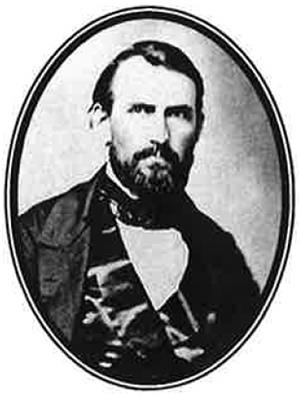On August 11, 1857, a group of North Coast Indians -- likely members of the Kake tribe of Tlingits who were led by a woman warrior -- behead Col. Isaac N. Ebey (1818-1857) at his home, "The Cabins," near Ebey's Landing. These Indians were likely retaliating for the killing of 27 tribal members, including a chief, by the U.S. warship Massachusetts the previous year. It is an oral tradition of the Kake tribe of Tlingits that the raid was led by a female relative of a chief slain in the Massachusetts incident. The oral tradition further specifies that the female leader of the raid was a member of the Tsaagweidi clan.
The white settlers on Whidbey Island -- including Ebey, who was the first to file a land claim there under the Donation Claims Law in 1850 -- had little to fear from the local Indians, but the northern Indians periodically staged raids on the local population. In August 1857, a group of these northern Indians came to Whidbey, reportedly seeking to take their revenge by killing John Coe Kellogg, the "Canoe Doctor," who was well-known in Port Gamble. They viewed Kellogg as a sort of white Tyee.
According to reports at the time, Kellogg was in Port Gamble, away from his Whidbey Island claim, when the Indians came calling. The Indians proceeded to question local residents about Ebey and whether he was a Tyee of the white population. They were told that he was a leader, whereupon they determined that if they could not kill Kellogg, they would take their revenge on Ebey instead.
The following night, they went to The Cabins and fired a gun outside. When Ebey came outside to assess the trouble, they killed him. His headless body was later found outside the door of his house.
The Ebey family, including Mrs. (Emily Sconce) Ebey, escaped before the northern Indians ransacked the home, taking all the clothing and bedding. Ebey was the only reported white casualty of the so-called Indian War of 1856-1857.
In 1978 Congress set aside Ebey's Landing Historical Reserve to preserve and protect the prairie, shoreline, and buildings, a cultural landscape that is a laboratory of Northwest history. This was the nation's first National Historical Reserve and is a non-traditional part of the National Park system. According to the National Park Service:
"It is the first unit of its kind in the system, with most of the land under private ownership. A unit of local government, the Trust Board of Ebey's Landing National Historical Reserve, is charged with management as called for in the legislation creating the Reserve. The Trust Board is a partnership of local, state and federal governments working collaboratively to ensure the historic and natural resources of the reserve are protected for future generations to enjoy and experience."

